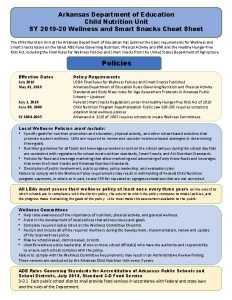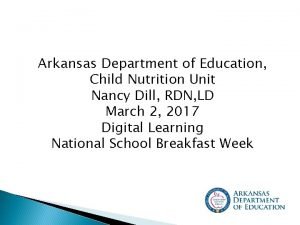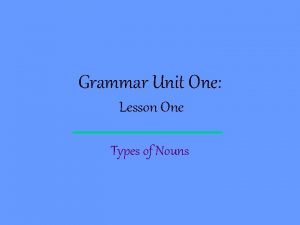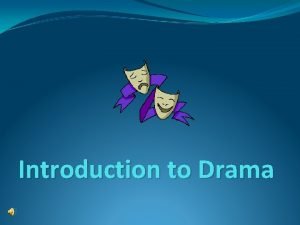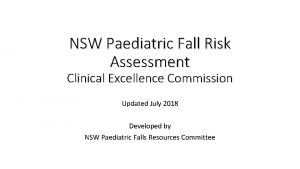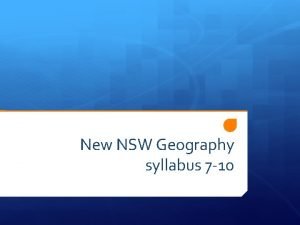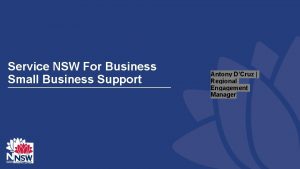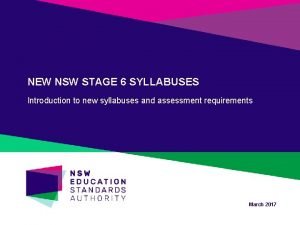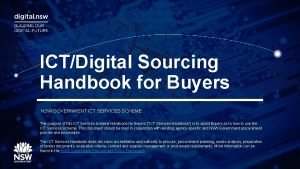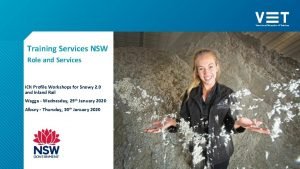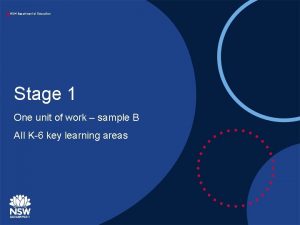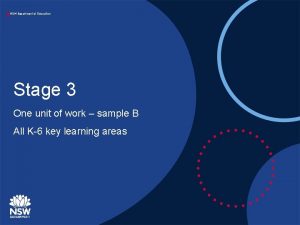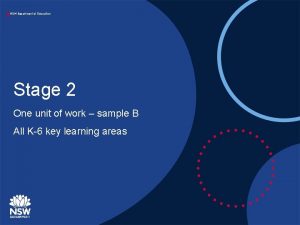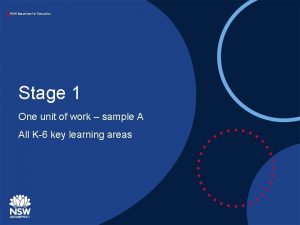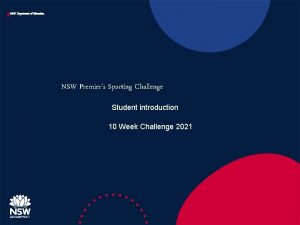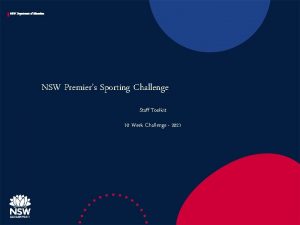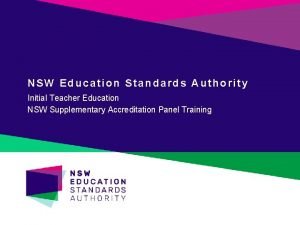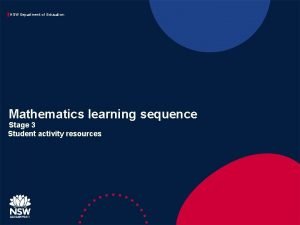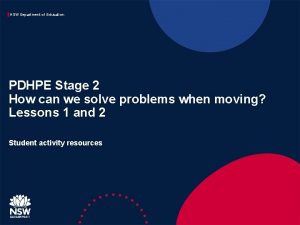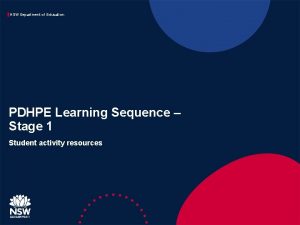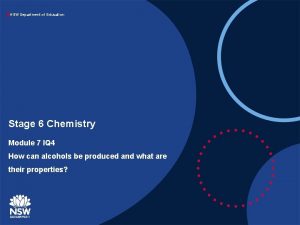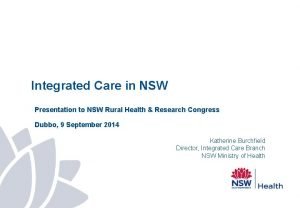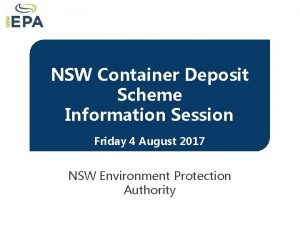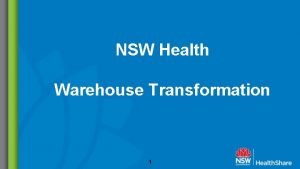NSW Department of Education Stage 2 One unit








































- Slides: 40

NSW Department of Education Stage 2 One unit of work – sample A All K-6 key learning areas

NSW Department of Education How to use this resource Each key learning area has sequential activities linked to outcomes. Choose the activities you wish to use and cut and paste them into your weekly class timetable with the resource links. Where relevant, there are sample worksheet templates provided with the task. English This resource includes 5 sequential tasks, with outcomes, from various English objectives. Each task has a duration between 45 minutes and 1 hour. Links to the online resources have been included with the tasks. Science and technology HSIE Mathematics This resource includes 5 sequential tasks, with outcomes, from a Mathematics strand sub strand. Each task has a duration between 45 minutes and 1 hour. Links to the online resources have been included with the tasks. PDHPE Creative arts This resource includes 3 sequential tasks, with outcomes, for each key learning area. Each task has a duration between 30 minutes and 1 hour. Links to the online resources have been included with the tasks. Stage 2 Week A

NSW Department of Education Support for assessment and feedback Advice and resources The department’s Curriculum planning and programming, assessing and reporting to parents K-12 policy informs school-based decisions about assessment and reporting processes. A collection of ready-to-use assessment tasks, assessment activity templates and tools have been developed to support assessment and feedback. These resources could be used in both face-to-face and online classroom settings. Professional learning The strategies for assessment and feedback for K-6 professional learning provides a guide for K-6 teachers about how to assess and provide feedback online to students. It also provides advice to support parents and carers of K-6 students with assessment and feedback. Access the My. PL link to this professional learning under the primary curriculum section of the website.

NSW Department of Education English – overview of tasks Objective A 1. Speaking and listening – ‘Guess my character’ 2. Writing and representing – ‘Character goals and flaws’ 3. Reading and viewing – ‘Characters, what do they do? ’ 4. Writing and representing – ‘Character perspective’ 5. Handwriting and using digital technologies – ‘Publish character perspective’ Stage 2 Week A

NSW Department of Education English task 1 – 45 minutes Objective A Speaking and listening 1 – EN 2 -1 A – ‘Guess my character’ What do to: • choose a familiar character from a text (movie or book) • without naming the character, describe that character to an adult, focusing on the character’s appearance, behaviours/actions and personality • the adult will try to guess the character, using the clues given. • after the adult has guessed correctly (or given up trying) complete the Y-chart with your character’s descriptions of appearance, behaviours/actions and personality. • draw a picture of your character in the centre of the Y-chart. Does it match your description? Stage 2 Week A

NSW Department of Education English task 2 - 45 minutes Objective A Writing and representing 1 – EN 2 -2 A – ‘Character goals and flaws’ What to do: • • • a character flaw can be defined more fully as an undesirable quality in a person a character goal is what a character wants. think about the character you described in Task 1. You will identify and write three sentences about the character: o one on appearance o one on goals o one on flaws. Example: Robin Hood is a tall, strong athlete man who usually wears green to blend in with the trees. Robin Hood has one goal, to steal from the rich and give to the poor. His flaws are that he was bossy and arrogant and stole a lot. Stage 2 Week A

NSW Department of Education English task 3 – 45 minutes Objective A Reading and viewing 1 – EN 2 -4 A – ‘Characters, who are they? ’ What to do: • after watching the character video, write your answers to the following questions: • do characters always have to be human? Explain. • why are characters important in a story? • how do authors get their audience to connect with characters? • what are some examples of character goals? What was the goal of the volcano? • what are some examples of character flaws? Stage 2 Week A

NSW Department of Education English task 4 – 1 hour Objective A Writing and representing 1 – EN 2 -2 A – ‘Character perspective’ What to do • imagine you are a character in a well-known fairy tale (e. g. the Wolf in The Three Little Pigs, the Witch in Hansel and Gretel or Grandma in Little Red Riding Hood) • retell a part of this story from a character's point of view. Plan and draft a short recount of this scene from your character’s perspective. Hint: Write like you are the character (first person). How did this scene make you feel? Use your 5 senses to add to the descriptions about this scene. Stage 2 Week A

NSW Department of Education English task 5 – 1 hour Objective A Handwriting and using digital technologies – EN 2 -3 A – ‘Publish character perspective’ What to do: • publish your character’s viewpoint using NSW Foundation Style cursive, making sure that you think about the letter joins, size, slope and spacing of your handwriting • if possible, download a picture of your character’s scene from the movie or book and paste it next to your published handwriting. Stage 2 Week A

NSW Department of Education Mathematics – overview of tasks 1. Measurement and geometry – area/ pentominoes 1 2. Measurement and geometry – length/ pentominoes 2 3. Number and algebra – whole numbers/ ‘Hit It’ 4. Measurement and geometry – two dimensional space/ tangrams 1 5. Measurement and geometry – area, number and algebra/tangrams 1: exploring trapeziums Stage 2 Week A

NSW Department of Education Mathematics task 1 – 45 minutes Measurement and geometry – Area 1 – MA 2 -10 MG – ‘Pentominoes 1’ Working mathematically outcomes: MA 2 -1 WM, MA 2 -2 WM, MA 2 -3 WM What to do: • view this video on Pentominoes – 1 • find all the unique shapes you can make using all 5 squares. Remember, the edges of each square must join other squares perfectly and each of the shapes you make must be different. That means that two shapes are considered the same if one can be fitted exactly on top of the other, even if you have to turn it around or turn it over. • Record your thinking on grid paper. Stage 2 Week A

NSW Department of Education Mathematics task 2 - 45 minutes Measurement and geometry – Length 2 – MA 2 -9 MG – ‘Pentominoes 2’ Working Mathematically outcomes: MA 2 -1 WM, MA 2 -2 WM, MA 2 -3 WM What to do: (Adapted from Pentominoes zoo) • view video on Pentominoes 2 page • what other shapes can you make by joining your pentominoes together? Show your thinking on the grid paper • can you make a rectangle? • can you make more than one rectangle? • form a rectangle with the smallest possible perimeter • form a rectangle with the largest possible perimeter • try making some of these from Abaroth’s World. After making them, you may like to colour them in to match your pentominoes. Stage 2 Week A

NSW Department of Education Mathematics task 3 – 45 minutes Number and Algebra – Whole numbers– MA 2 -4 NA – ‘Hit It’ Working mathematically outcomes: MA 2 -1 WM, MA 2 -2 WM, MA 2 -3 WM What to do: • view video Hit it! (From Mike Askew) • play Hit it! You can play this game using 2 -, 3 -, 4 - or 5 - digit numbers and beyond. You can even play with decimal fractions! • draw up your game board (in this game, we were working with 3 -digit numbers but you can use larger or smaller numbers if you like) • select a multiple of hundred between 100 and 900 to be your target number • the person with the most letters in their surname goes first • take it in turns to roll the dice and use the digit somewhere in your number • once the digits are full, players read their number and determine how far they are away from the target number. The player who is closest to the target number wins a point • the winner with the most points after 3 rounds is declared the winner. • Reflection - What would you do differently if you played ‘Hit it!’ again tomorrow? Please explain your reasoning. Stage 2 Week A

NSW Department of Education Mathematics Task 4 – 45 minutes Measurement and geometry – Two dimensional space 2 – MS 2 -15 MG – ‘Tangrams 1 ’ Working Mathematically outcomes: MA 2 -1 WM, MA 2 -2 WM, MA 2 -3 WM What to do: • view video How to make a tangram • you will need: o pair of scissors o 1 square sheet of paper o view video on how to make a square • view video ‘How to make a tangram’ and then make your own tangram. Stage 2 Week A

NSW Department of Education Mathematics task 5 – 45 minutes Measurement and geometry – Area 1 – MA 2 -10 MG – ‘Tangrams 2’ Working mathematically outcomes: MA 2 -1 WM, MA 2 -2 WM, MA 2 -3 WM What to do: • view video Tangrams –part 1 • use this Adapted Frayer chart to define a trapezium (you can print it or save a copy on your computer • view video Tangrams –part 2 How many different trapeziums can you make using your tangram pieces? Make a trapezium using: o 2 tangram pieces o 3 tangram pieces o 4 tangram pieces o 5 tangram pieces o 6 tangram pieces o 7 tangram pieces • record your creations in your workbook or by taking photographs. Stage 2 Week A

NSW Department of Education Science and technology – overview of tasks Living world 1. Classifying things (sample worksheet provided) 2. Aboriginal plant use (sample worksheet provided) 3. Using branching to classify items (sample worksheet provided) Stage 2 Week A

NSW Department of Education Science and technology task 1 – 45 minutes Living world – ST 2 -1 WS-S, ST 2 -4 LW-S – ‘Classifying things’ Focus question: How can we group living things? What to do: § safety is important, dangerous items such as sharp knives or electrical appliances should not be included in your collection • identify, collect and list 15 -20 items from your kitchen or bedroom • sort the items into different groups after looking at the examples (see next slide) • make a list of the items in each group and the number of items in each group. • explain and justify why you grouped specific items together. Remember to use observable (external) features and characteristics in your explanation for example, colour, texture, shape, or material it is made from. Stage 2 Week A

NSW Department of Education Science and technology task 1 continued List of items Stage 2 Week A

NSW Department of Education Science and technology task 2 – 1 hour Living world – ST 2 -1 WS-S, ST 2 -4 LW-S – ’Aboriginal plant use’ Focus question: How can we group living things? What to do: • many living things were grouped by Aboriginal and Torres Strait Islander peoples based on their use. For example, the Bracken's root which is found in the ground was used for food to make pancakes • view the ABC video – Chapter 9 Useful plants. • after watching the video, complete the table (see next slide) by identifying some of the plants and what they were used for. Stage 2 Week A

NSW Department of Education Science and technology task 2 continued Plants Cucumbers Apples Olive tree Eucalyptus leaves Stage 2 Week A Uses

NSW Department of Education Science and technology task 3 – 1 hour Living world – ST 2 -3 DP-T, ST 2 -4 LW-S, ST 2 -11 DI-T – ‘Using branching to classify items’ Focus question: How can we group living things? What to do: • branching is a decision-making tool. Computers uses branching instructions to make decisions. See example of the next slide • view the ‘Field of Mars’ video – Creating your own classification key. • after watching the video, choose a category of items to classify. Choose 10 -15 items to sort. Write your list of items in the table (see next slide) • identify patterns in your group of items. Identify similarities and differences between your items • use yes/no questions to create a step-by-step process of branching questions to sort the items • after creating the branching questions, use our classification system or branching key, to classify the 1015 items • use a written explanation to explain your reasons for choosing the questions in your classification system Stage 2 Week A

NSW Department of Education Science and technology task 3 continued List of items Stage 2 Week A Classification systems

NSW Department of Education HSIE geography – overview of tasks The Earth’s environment 1. Native vegetation 2. Natural healing and medicines 3. Native animals. Stage 2 Week A

NSW Department of Education HSIE geography task 1 – 1 hour The Earth’s environment – GE 2 -1 – ‘Native Vegetation’ Key inquiry question – How does the environment support the lives of people and other living things? What to do: • Australia has very different types of native plants (vegetation) that can’t be found anywhere else in the world. • create a T-chart to compare the native plants found in Australia with native plants of a country in Asia. If you can, include some photos or drawings of the plants. • under your T-chart, explain why you think the native vegetation in your chosen country is so different to Australia’s native vegetation. Support resources – additional resources for Asia continent Asia -destination world- Nat Geo kids Continent of Asia- Kids Learning Tube Stage 2 Week A

NSW Department of Education HSIE geography task 2 – 45 minutes The Earth’s environment – GE 2 -2 – ‘Natural healing and medicines’ Key inquiry question – How does the environment support the lives of people and other living things? What to do: • investigate natural healing properties and medicines that native Australian vegetation has been used to make as a natural treatment to many illnesses and injuries • choose 5 native plants that are types of bush medicine and describe how they can heal living things. Stage 2 Week A

NSW Department of Education HSIE geography task 3 – 45 minutes The Earth’s environment – GE 2 -2 – ’Native animals’ Key inquiry question – How does the environment support the lives of people and other living things? What to do: • native Australian vegetation is also important to sustain our native animals and environment. It plays a key part in our native animals’ habitats and health. Without our Australian native vegetation we could see many of our precious native animals become endangered or extinct • research one native Australian animal and describe how it relies on native vegetation for both food and survival. Stage 2 Week A

NSW Department of Education PDHPE – overview of tasks Health, wellbeing and relationships 1. Roles and relationships (sample worksheet provided) 2. Respect and empathy (sample worksheet provided) Movement, skill and performance 3. Step or no step (sample worksheet provided) Stage 2 Week A

NSW Department of Education PDHPE task 1 – 45 minutes Health, wellbeing and relationships – PD 2 -3– ‘Roles and relationships’ Key inquiry question: Why are empathy, inclusion and respect important in our relationships? What to do: • we all perform many different roles in our lives. Some examples are student, team mate, best friend, bus driver, doctor or teacher. When we talk about a role in a relationship we mean the expected behaviour and obligations of a person in that position. For example, the role of a police officer is to help the community by keeping people safe, helping people in need and reducing crime. Discuss with an adult the following questions. o what are some of the roles within the classroom? o why is it important to have roles within the classroom? • draw an arrow to match the role with the appropriate responsibilities (see next slide). Stage 2 Week A

NSW Department of Education PDHPE task 1 continued Draw an arrow to match the role with the appropriate responsibilities below. Role Responsibilities of the role Teacher Support the school, care for and support their own child. Parent/caregiv er Care for and teach students, communicate with parents. Student Leads the school, support teachers, students and parents. Principal Learn, respect all members of the school community and try their personal best. Stage 2 Week A

NSW Department of Education PDHPE task 2 – 45 minutes Health, wellbeing and relationships – PD 2 -3 – ‘Respect and empathy’ Key inquiry question: Why are empathy, inclusion and respect important in our relationships? What to do: Discuss with an adult the following questions. • o what is respect? What is disrespect? o why is it important to be respectful and not disrespectful? o what is empathy? o how do we show empathy towards our peers and in the community? match each scenario with an appropriate response (see next slide). Draw an arrow to indicate your answer. • identify the type of behaviour demonstrated in the response column by circling one of the three options. (Respectful/Disrespectful/Empathy) • reflect upon the answers you provided. Using your answers, consider how you can demonstrate respect to others. Complete the sentences (see next slides) Stage 2 Week A

NSW Department of Education PDHPE task 2 – part 1 Match each scenario in your workbook with an appropriate response. Draw an arrow to indicate your answer. Identify the type of behaviour demonstrated in the response column by circling on of the three options (respectful/disrespectful/empathy). Response Scenario 1. A new student has joined your class and is sitting alone at lunch time. They are crying and look very sad. a) You may not always agree with a response you are given but you should always talk calmly and respectfully about the issues. respectful/disrespectful/empathy 2. A number of your classmates are ignoring the teacher’s instructions by throwing objects and yelling rude comments. 3. You really want to go to a friend’s house for a play on the weekend but you have been told you can’t go. You scream really loudly that you hate everyone and slam the bedroom door. Stage 2 Week A b) You think how hard it would be if you had to start at a new school. You walk over, introduce yourself and ask if you could sit with them. The student talks to you about how they are feeling and you acknowledge these feelings. respectful/disrespectful/empathy c) You ask the students being rude to stop because their behaviours are making you feel uncomfortable. You ask them to follow the teacher’s instructions so everyone can learn. respectful/disrespectful/empathy

NSW Department of Education PDHPE task 2 – part 2 Reflect upon the answer you provided. Using your answers, consider how you can demonstrate respect to others. Complete the sentences. I can be respectful to my parents/caregivers by… ____________________________________________________________________ ____________________ I can be respectful to my teacher by… ____________________________________________________________________ ____________________ I can be respectful to my friends by… ____________________________________________________________________ ____________________ Stage 2 Week A

NSW Department of Education PDHPE task 3 – 45 minutes Movement, skill and performance – PD 2 -4, PD 2 -5 – ‘Step or no step? ’ Key inquiry question: How can we move our bodies to perform skills in different ways? What you’ll need: • a soft object to throw (for example, soft ball, pair of socks, scrunched-up paper) • an object or landmark to create a target for the object to hit (for example, a bucket, a long piece of string laid in a circle, an ‘X’ formed by two pieces of tape/material, a t-shirt laid on the ground, a chair/bench, a wall, a tree) • refer to 'Hit the target' game card for suggestions of what this activity could look like. What to do: • create a target that you can safely throw a soft object towards. Choose a ‘starting point’ where you will throw the object from. You will use two types of throw: • 1. stand throw 2. step and throw the object towards the target. You should aim to hit the target. Pick up the object from where it landed and throw the object again until the target has been hit • repeat the challenge 5 times for each type of throw attempting to hit the target in a fewer number of throws • record how many throws it took to hit the target (see next slide). Stage 2 Week A

NSW Department of Education PDHPE task 3 – part 1 Examples of ‘Step or no step’ Step or no step Stand throw Step and throw Stage 2 Week A Attempt 1 Attempt 2 Attempt 3 Attempt 4 Attempt 5

NSW Department of Education PDHPE task 3 – part 2 Discuss these questions with your teacher or parent/caregiver. • What type of throw was successful? Why? • What type of throw was unsuccessful? Why? • Which type of throw was most comfortable for you to perform? Why? • Describe why you might choose to step and throw? • Why would a step help you when you throw? Challenge! Move the target or the starting line so you need to throw the object a longer distance. Stage 2 Week A

NSW Department of Education Creative arts- overview of tasks Visual arts – Connotation, imagery and symbol 1. Symbols around us 2. Symbolic sculpture 3. Artist representation (sample worksheet provided). Stage 2 Week A

NSW Department of Education Creative arts task 1 - 45 minutes Visual arts – VAS 2. 1, VAS 2. 1 – ‘Symbols around us’ What to do: • go outside to a special place within your school or local environment. Where possible take a plastic surface, some cardboard, a paver or alternatively find a concrete, tiled or paved area. Take some water in a container and a paintbrush • look around at the environment in silence. Find something important about the environment – either natural or man-made. • create a quick symbol of something in this environment that is important to you. Take a photo for your teacher to look at. Once it has vanished, repeat with another symbol and take a photograph. Your teacher wants to check you can show a symbol through your artwork. You can put your photos in the workbook. Artworks don’t always need to be permanent but that they do represent a meaning to the artist. Stage 2 Week A

NSW Department of Education Creative arts task 2 – 1 hour Visual arts – VAS 2 -2 – ‘Symbolic sculpture’ What to do: • look at the work ‘Centrepoint Tower’ by Aboriginal artist Esme Timbery from the collection at the Art Gallery of NSW. Timbery is a Bidjigal artist whose family were shell workers from the Aboriginal mission community of La Perouse in Sydney. How do you think this work was made? • did you notice how the artist used traditional materials (the shells) that are important to Aboriginal culture to show a modern city symbol (the tower)? • think again about your environment and look for an object that symbolises Australia to you. Remember if you take something from nature such as shells from the beach, it must be returned once your artwork is complete • create a symbolic sculpture artwork and photograph it. This may include leaves, shells or flowers and may also include cultural symbols important to your community or how you feel about Australia. Stage 2 Week A

NSW Department of Education Creative arts task 3 – 1 hour Visual arts – VAS 2 -3, VAS 2. 4 – ‘Artist representation’ What to do: • artists represent ideas and meanings of their world through their artworks just like you did in your own symbolic works. Artists have been doing this throughout history. Many of these artworks are from the collections at the Art Gallery of NSW • your teacher may have shown you the works below: o ‘Bailed up’ by Tom Roberts o ‘The future is now’ by Robert Rauschenberg o ‘The first real target’ by Peter Blake o ‘Football players’ by Konrad Lueg o ‘Triple fronted’ by Howard Arkley. • complete the information in the table (see next slide). This will show your understanding of the meaning of the artworks. The first one for ‘Bailed up’ by Tom Roberts has been done for you. Stage 2 Week A

NSW Department of Education Creative arts task 3 continued Artwork title and artist What is its hidden meaning about How does it tell us that? culture or country? ‘Bailed up’ by Tom Roberts Australia’s rugged bush, heat and bushrangers. ‘The future is now’ by Robert Rauschenberg ‘The first real target’ by Peter Blake ‘Football players’ Konrad Lueg ‘Triple fronted’ by Howard Arkley Stage 2 Week A The choice of colours and images
 Early childhood directorate
Early childhood directorate Department of primary industries and mines
Department of primary industries and mines Certificate iv in clinical classification nsw
Certificate iv in clinical classification nsw Stage 1 denial stage 2
Stage 1 denial stage 2 Child nutrition unit arkansas
Child nutrition unit arkansas Arkansas department of education child nutrition unit
Arkansas department of education child nutrition unit One empire one god one emperor
One empire one god one emperor One one one little dog run
One one one little dog run One king one law one faith
One king one law one faith Byzantine definition
Byzantine definition One team one plan one goal
One team one plan one goal See one do one teach one
See one do one teach one One price policy
One price policy Structure of twelfth night
Structure of twelfth night Studiendekanat uni bonn
Studiendekanat uni bonn Asean tourism strategic plan
Asean tourism strategic plan One vision one identity one community
One vision one identity one community Unit one lesson one
Unit one lesson one Unit one lesson one
Unit one lesson one Stage right stage left
Stage right stage left Proscenium stage diorama
Proscenium stage diorama Single stage tendering
Single stage tendering The word drama comes from
The word drama comes from Stage left vs stage right
Stage left vs stage right Unit 10, unit 10 review tests, unit 10 general test
Unit 10, unit 10 review tests, unit 10 general test Nsw health talent pool
Nsw health talent pool Falls risk assessment nsw
Falls risk assessment nsw Ess scheme nsw
Ess scheme nsw Iv fluid order
Iv fluid order Year 7 geography syllabus
Year 7 geography syllabus River systems nsw
River systems nsw Iwork for nsw
Iwork for nsw Hgen nsw health
Hgen nsw health Stress leave nsw
Stress leave nsw Sbir nsw
Sbir nsw Drink driving nsw facts
Drink driving nsw facts Life skills outcomes stage 6
Life skills outcomes stage 6 Labour hire insurance
Labour hire insurance Ict services scheme
Ict services scheme Plumbers direct
Plumbers direct Nsw state training services
Nsw state training services




